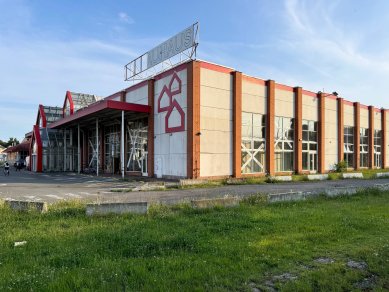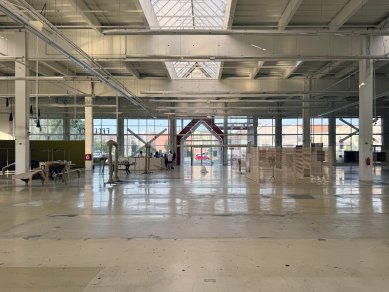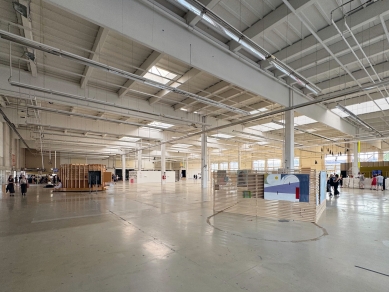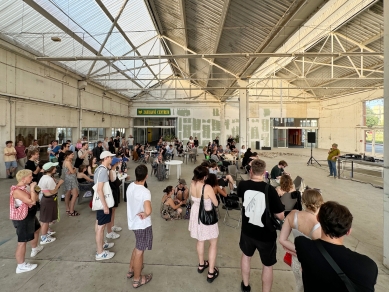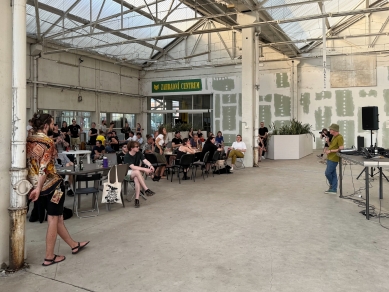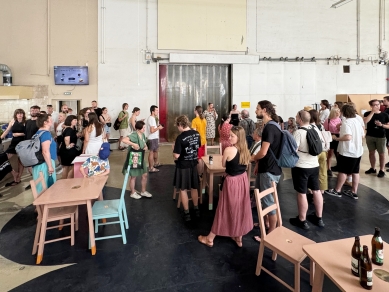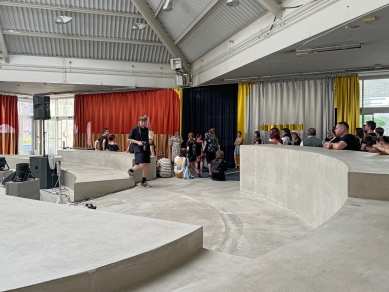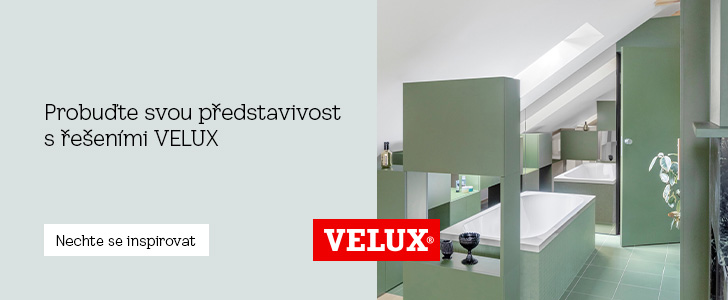
Goodbye, Bauhaus. PLATO is leaving the former hobby market after nearly seven years. Part of the activities will be moved to the slaughterhouse.
5000 square meters for contemporary art. With this slogan, the PLATO gallery invites visitors to its previous location, the building of a former DIY store. Since 2018, when the Ostrava City Gallery of Contemporary Art opened the Bauhaus building to the public, more than 200 artists, over 60 institutions, platforms, and communities, hundreds of schools, and thousands of visitors have passed through it. Its operation ends on the last day of June, as the city management plans new construction here long-term and considers the demolition of the building. The last two events will take place on Friday, June 28th at 5 PM and on Sunday, June 30th, 2024, at 4 PM.
On Friday, June 28th, a concert, guided tours, and a farewell party titled Goodbye, Bauhaus! are planned. From 5 PM to 10 PM, visitors can enjoy a DJ set and a campfire in the garden, followed by a guided tour at 6 PM, including backstage access on the first floor, and at 7:30 PM, the final concert of experimental electronic music, regularly organized by PLATO in collaboration with the Gin&Platonic platform. The London producer Klahrk and the emerging domestic experimental scene act sorbitol drops will perform on the stage.
On Sunday, June 30th, the very last event will take place in the building starting at 4 PM. It bears the telling title Removing the PLATO B Sign from the Bauhaus Building. The gallery invites everyone to watch the removal of the building's sign together.
The sign, or rather the structure, identical to the one that bears the designation, is related to the currently prepared project for the garden of the neighboring main PLATO headquarters. The structure will serve as the basis for outdoor furniture with shading, prepared by the architectural studio MAK!. Thus, the gallery foreshadows the fate of other Bauhaus elements, fragments of which will also become the foundation for the new autumn exhibition. A similar space for communities and the public will emerge in the largest hall of the main headquarters for seven months, just like in Bauhaus.
The Bauhaus served as the temporary headquarters of the city gallery for four and a half years. In the last two years, after the conversion of the former slaughterhouse building into the main headquarters of PLATO, it gained a new purpose and became a base for other organizations and communities as well. Due to its size, layout, furnishings, and operational style, for example, one Saturday at the beginning of June, a toddler art group, an event for staci-onars, painting within the Format Ostrava plein air festival, and a children's club in Ukrainian all accommodated side by side. They did not interfere with each other, filled the space, and there was still room left for café visitors and the exhibition of the Faculty of Arts of Ostrava University, Diplomky 2024.
The space, however, also offered other possibilities. At the beginning of June, on the stage, a platform for live performances by American author Than Hussein Clark, artists Markéta Sasínová and Jakub Choma got married. "If it weren't for the Bauhaus, we probably would have gotten married in about three years. But since it's closing, we just had to have our wedding here. We love it here," said the bride.
The popularity of the place, and thus the success with which the gallery has built and operated it, is also reflected in the public petition responding to the decision to end activities here. "We are aware of the uniqueness of the connection between artistic and community activities that has been built in PLATO Bauhaus. Our team has left a piece of their life in PLATO Bauhaus. In our opinion, Ostrava needs a similar low-threshold space. It is not just a building, but primarily about relationships, about the trust of communities and the provider of support,” states the gallery director Marek Pokorný.
Since 2018, over 200 artists from Ostrava, the Czech Republic, and abroad have exhibited in the Bauhaus, utilized by more than 60 institutions and platforms, hundreds of schools, and thousands of visitors. The functional zones in the Bauhaus space, such as the stage, cinema, bistro, library, etc., are also works of art created during the first two years by artists from the Czech Republic, Poland, France, the USA, and Belgium. Elements referencing the building's former function, such as signs or paintwork, were intentionally preserved in the interior. The concept of the space and its usage was developed by a curatorial team consisting of Marek Pokorný, Linda and Daniela Dostálkovy, Michal Novotný, Jakub Adamec, and Edith Jeřábková.
On Friday, June 28th, a concert, guided tours, and a farewell party titled Goodbye, Bauhaus! are planned. From 5 PM to 10 PM, visitors can enjoy a DJ set and a campfire in the garden, followed by a guided tour at 6 PM, including backstage access on the first floor, and at 7:30 PM, the final concert of experimental electronic music, regularly organized by PLATO in collaboration with the Gin&Platonic platform. The London producer Klahrk and the emerging domestic experimental scene act sorbitol drops will perform on the stage.
On Sunday, June 30th, the very last event will take place in the building starting at 4 PM. It bears the telling title Removing the PLATO B Sign from the Bauhaus Building. The gallery invites everyone to watch the removal of the building's sign together.
The sign, or rather the structure, identical to the one that bears the designation, is related to the currently prepared project for the garden of the neighboring main PLATO headquarters. The structure will serve as the basis for outdoor furniture with shading, prepared by the architectural studio MAK!. Thus, the gallery foreshadows the fate of other Bauhaus elements, fragments of which will also become the foundation for the new autumn exhibition. A similar space for communities and the public will emerge in the largest hall of the main headquarters for seven months, just like in Bauhaus.
The Bauhaus served as the temporary headquarters of the city gallery for four and a half years. In the last two years, after the conversion of the former slaughterhouse building into the main headquarters of PLATO, it gained a new purpose and became a base for other organizations and communities as well. Due to its size, layout, furnishings, and operational style, for example, one Saturday at the beginning of June, a toddler art group, an event for staci-onars, painting within the Format Ostrava plein air festival, and a children's club in Ukrainian all accommodated side by side. They did not interfere with each other, filled the space, and there was still room left for café visitors and the exhibition of the Faculty of Arts of Ostrava University, Diplomky 2024.
The space, however, also offered other possibilities. At the beginning of June, on the stage, a platform for live performances by American author Than Hussein Clark, artists Markéta Sasínová and Jakub Choma got married. "If it weren't for the Bauhaus, we probably would have gotten married in about three years. But since it's closing, we just had to have our wedding here. We love it here," said the bride.
The popularity of the place, and thus the success with which the gallery has built and operated it, is also reflected in the public petition responding to the decision to end activities here. "We are aware of the uniqueness of the connection between artistic and community activities that has been built in PLATO Bauhaus. Our team has left a piece of their life in PLATO Bauhaus. In our opinion, Ostrava needs a similar low-threshold space. It is not just a building, but primarily about relationships, about the trust of communities and the provider of support,” states the gallery director Marek Pokorný.
Since 2018, over 200 artists from Ostrava, the Czech Republic, and abroad have exhibited in the Bauhaus, utilized by more than 60 institutions and platforms, hundreds of schools, and thousands of visitors. The functional zones in the Bauhaus space, such as the stage, cinema, bistro, library, etc., are also works of art created during the first two years by artists from the Czech Republic, Poland, France, the USA, and Belgium. Elements referencing the building's former function, such as signs or paintwork, were intentionally preserved in the interior. The concept of the space and its usage was developed by a curatorial team consisting of Marek Pokorný, Linda and Daniela Dostálkovy, Michal Novotný, Jakub Adamec, and Edith Jeřábková.
The English translation is powered by AI tool. Switch to Czech to view the original text source.
